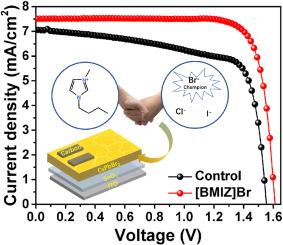Interface engineering with halide anion ionic liquids: A strategy to enhance the efficiency and stability of carbon-based all-inorganic CsPbBr3 perovskite solar cells
IF 7.9
2区 工程技术
Q1 CHEMISTRY, PHYSICAL
引用次数: 0
Abstract
Carbon-based all-inorganic CsPbBr3 perovskite solar cells (PSCs) have garnered significant interest owing to their cost-effective production processes and exceptional thermal stability. Nonetheless, defects within CsPbBr3 films and inefficient charge extraction in PSCs result in pronounced charge recombination, thereby reducing the overall device efficiency. Herein, the Pb2+ and Cs+ defects are simultaneously passivated by introducing halide anion ionic liquids at the interface between CsPbBr3 and carbon, significantly improving film quality and crystallinity and prolong the average carrier lifetime. Moreover, the non-radiative recombination is efficiently inhibited in the film with reduced defects and enhanced light absorption capability, resulting in an enhancement of both open-circuit voltage (VOC) and fill factor (FF). Finally, all-inorganic CsPbBr3 PSCs passivated by BMIZ-Br ionic liquid achieved a superior efficiency of 9.34 % with a high VOC of 1.587 V. This work provides scientific insights into interface engineering to enhance the efficiency and long-term stability of CsPbBr3-based PSCs, thereby promoting the advancement of perovskite-based optoelectronic technologies.

卤化物阴离子液体界面工程:提高碳基全无机CsPbBr3钙钛矿太阳能电池效率和稳定性的策略
碳基全无机CsPbBr3钙钛矿太阳能电池(PSCs)由于其具有成本效益的生产工艺和优异的热稳定性而获得了极大的兴趣。然而,CsPbBr3薄膜内部的缺陷和PSCs中低效的电荷提取导致明显的电荷重组,从而降低了器件的整体效率。通过在CsPbBr3与碳的界面处引入卤化物阴离子液体,同时钝化了Pb2+和Cs+缺陷,显著改善了薄膜质量和结晶度,延长了平均载流子寿命。此外,薄膜中的非辐射复合被有效抑制,减少了缺陷,增强了光吸收能力,从而提高了开路电压(VOC)和填充因子(FF)。BMIZ-Br离子液体钝化CsPbBr3 PSCs的效率高达9.34%,VOC高达1.587 V。这项工作为界面工程提供了科学的见解,以提高基于cspbbr3的PSCs的效率和长期稳定性,从而促进钙钛矿基光电技术的发展。
本文章由计算机程序翻译,如有差异,请以英文原文为准。
求助全文
约1分钟内获得全文
求助全文
来源期刊

Journal of Power Sources
工程技术-电化学
CiteScore
16.40
自引率
6.50%
发文量
1249
审稿时长
36 days
期刊介绍:
The Journal of Power Sources is a publication catering to researchers and technologists interested in various aspects of the science, technology, and applications of electrochemical power sources. It covers original research and reviews on primary and secondary batteries, fuel cells, supercapacitors, and photo-electrochemical cells.
Topics considered include the research, development and applications of nanomaterials and novel componentry for these devices. Examples of applications of these electrochemical power sources include:
• Portable electronics
• Electric and Hybrid Electric Vehicles
• Uninterruptible Power Supply (UPS) systems
• Storage of renewable energy
• Satellites and deep space probes
• Boats and ships, drones and aircrafts
• Wearable energy storage systems
 求助内容:
求助内容: 应助结果提醒方式:
应助结果提醒方式:


